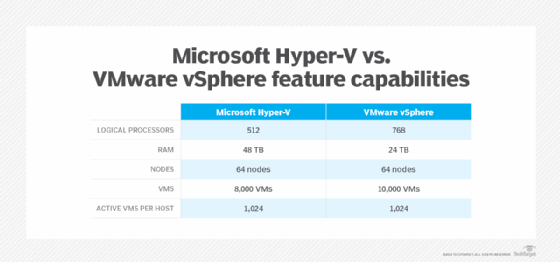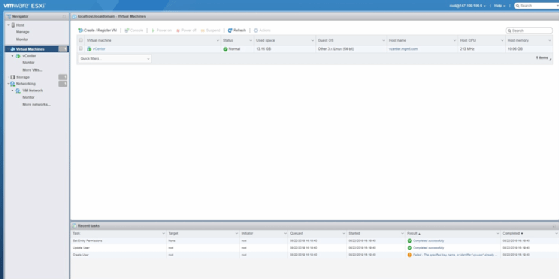Microsoft Hyper-V vs. VMware vSphere: Feature comparison
Hyper-V and VMware are in a perpetual battle for supremacy in the virtualization market. Although the hypervisors have similar features, they differ on some key capabilities.
For years, VMware vSphere was the sensible choice for enterprise-class server virtualization. However, Microsoft has made drastic improvements to Hyper-V over the years and continues to steadily improve the platform. Choosing between the two comes down to the fine details.
Both VMware and Microsoft offer highly capable platforms. Both companies have products for small shops but also sell products with features suitable for the largest enterprise environments. In fact, VMware vSphere and Hyper-V have an extremely comparable feature set. Both products offer roughly the same core feature set and support capabilities, such as network virtualization, VM migration, storage migration and network interface card teaming.
In areas such as feature capabilities, cost and licensing, management tools and infrastructure, these two virtualization options differ. As such, teams must explore the question of using Hyper-V vs. VMware vSphere in their data center and examine the differences between the two.
Hyper-V vs. VMware vSphere: Feature capabilities
Although the two hypervisors have similar feature sets, their feature capabilities differ. For example, there are significant differences in Hyper-V vs. VMware vSphere hypervisors in terms of scalability. Hyper-V hosts can support up to 512 logical processors as opposed to vSphere's 768. Although VMware supports a larger number of logical processors, Hyper-V supports more RAM. Hyper-V servers can address up to 48 TB of RAM, whereas VMware vSphere 8.0 is only able to address 24 TB of RAM.
Hyper-V and vSphere have somewhat similar cluster level scalability. A Hyper-V cluster can include up to 64 nodes and support up to 8,000 VMs, with a maximum of 1,024 active VMs on any given host. In contrast, VMware vSphere clusters can also include up to 64 nodes but support a maximum of 10,000 VMs per cluster along with their maximum of 1,024 VMs per host.

Although VMware vSphere can accommodate more virtual machines per cluster than Hyper-V is able to, it's important to consider how organizations use hypervisors. Many large organizations find it more useful to create multiple clusters of a relatively small size rather than build hyperscaled clusters. Smaller clusters tend to be easier to manage, and having several small clusters rather than a single large one mitigates some of the effects of a cluster-level failure. This isn't to say that VMware's hypervisor scalability isn't impressive or useful but rather that right now, there aren't many organizations taking full advantage of it.
Microsoft Hyper-V
While Hyper-V and VMware v-Sphere share certain similarities, the tools also have unique characteristics. Evaluate Hyper-V's cost and licensing, management tools and infrastructure to see what sets it apart from vSphere.
Cost and licensing
One major difference between Hyper-V and VMware vSphere is the way the products are licensed. Microsoft includes Hyper-V with Windows Server. A single Datacenter license is valid for up to 16 CPU cores and allows for an unlimited number of VMs running on the host. As a bonus, the Datacenter license enables each VM running on the host to run Windows Server without requiring an extra OS license. However, Microsoft also requires client access licenses for each user or device that accesses Windows Server.
In terms of pricing, all of Hyper-V's core capabilities are included with a Windows Server license. Features such as Live Migration don't cost extra to use.
Management tools
Microsoft takes a simplified approach to its products. As previously mentioned, Hyper-V is included with Windows Server and therefore includes a built-in management tool called the Hyper-V Manager (Hyper-V can also be managed using PowerShell). Larger organizations that require enterprise management capabilities will also likely need System Center Virtual Machine Manager. However, that is pretty much the extent of Microsoft's Hyper-V offerings.

Hyper-V infrastructure
The Hyper-V infrastructure is relatively simple. Hyper-V exists as a Windows Server role, meaning that a Hyper-V server is a Windows Server that has Hyper-V enabled. If an organization requires high availability, the Windows Failover Clustering feature can provide it.
Hyper-V administrators can take advantage of similar capabilities that VMware vSphere has, such as software defined storage, software defined networking, advanced automation, operations management, log insights and disaster recovery. While VMware offers these capabilities as additional products, the required components for Hyper-V are either integrated into the Windows operating system or require third party products.
VMware vSphere
In comparison to Hyper-V, VMware vSphere has its own share of unique capabilities for organizations to consider.
Cost and licensing
In terms of cost and licensing, VMware offers dozens of different products or product variations. On one hand, this means VMware can offer its customers extreme granularity by giving them the exact features and capabilities they need. On the other hand, there are so many different products to choose from that it can be difficult for an inexperienced IT administrator to know which products to purchase.
Management tools
VMware's primary management tool is vCenter Server, which is a part of the vSphere suite of products. VMware environments can also be managed using VMware ESXCLI, VMware's command line utility. Additionally, VMware offers various special purpose management tools such as VMware Carbon Black, used for threat detection, and VMware Workspace ONE for Unified Endpoint Management.

Infrastructure
VMware deployments can differ significantly from one another based on an organization's needs. The core deployment is based on vSphere, which includes ESXi, the hypervisor; vCenter Server, the management tool; and vCenter Update Manager, a tool for managing software updates.
VMware offers numerous additional products that organizations can add based on their needs. For example, an organization might use VMware vSAN to enable software defined storage, or VMware NSX for software defined networking. Similarly, the VMware vRealize Suite provides advanced automation, operations management and log insights. Disaster recovery capabilities are tied to the VMware Site Recovery Manager. These are only a sampling of the products available from VMware.
Hyper-V and VMware vSphere similarities
Hyper-V and vSphere share a common set of core features, although Microsoft and VMware often have different names for those features.
Both vSphere and Hyper-V are designed to be lightweight and to deliver the level of performance required for mission critical workloads. In the past, Hyper-V was sometimes criticized for its dependence on Windows Server, which requires system resources beyond those needed for the hypervisor. However, Hyper-V can be deployed in a server core configuration, which eliminates the Windows GUI and makes a Hyper-V deployment much lighter weight than it otherwise would be.
Hyper-V and VMware both use hardware assisted virtualization and can be centrally managed. Both platforms also support migrating running virtual machines between hosts. Microsoft calls this feature live migration, while VMware refers to it as vMotion.
VMware and Hyper-V also each offer fine-grained control over the resources allocated to virtual machines, also supporting dynamic memory allocations. The two platforms also offer controls to prevent a virtual machine from overwhelming the host with excessive I/O requests.
From a security standpoint, both platforms offer standard security capabilities, such as the ability to use secure boot and virtual TPM. Both platforms also offer their own unique security features as well.
Evaluating the pros and cons
Both VMware and Microsoft have compelling arguments as to why their respective products are the best. Feature-wise, the two products are too similar to one another to definitively declare one product better than the other. Besides, there are other criteria to consider beyond the feature set. For instance, VMware is a more mature product, and there are more third-party products designed to work with VMware than Hyper-V.
Conversely, it's often far less expensive to deploy Hyper-V than vSphere, but not always. Additionally, Hyper-V tends to have a simpler management interface, and many administrators therefore consider Hyper-V to be the easier product to use. In contrast, VMware tends to be a more feature-rich platform.
Ultimately, VMware vSphere and Hyper-V are more evenly matched than they have ever been in the past. As such, organizations who are choosing a virtualization platform should focus on the IT department's skill set, compatibility with the existing environment, and the deployment and management costs to pick the right option for them.







